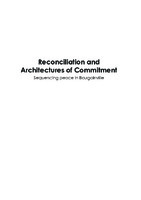Reconciliation and Architectures of Commitment: Sequencing peace in Bougainville
Author(s)
Braithwaite, John
Charlesworth, Hilary
Reddy, Peter
Dunn, Leah
Language
EnglishAbstract
Following a bloody civil war, peace consolidated slowly and sequentially in Bougainville. That sequence was of both a top-down architecture of credible commitment in a formal peace process and layer upon layer of bottom-up reconciliation. Reconciliation was based on indigenous traditions of peacemaking. It also drew on Christian traditions of reconciliation, on training in restorative justice principles and on innovation in womens’ peacebuilding. Peacekeepers opened safe spaces for reconciliation, but it was locals who shaped and owned the peace. There is much to learn from this distinctively indigenous peace architecture. It is a far cry from the norms of a ‘liberal peace’ or a ‘realist peace’. The authors describe it as a hybrid ‘restorative peace’ in which ‘mothers of the land’ and then male combatants linked arms in creative ways. A danger to Bougainville’s peace is weakness of international commitment to honour the result of a forthcoming independence referendum that is one central plank of the peace deal.
Keywords
politics and government; papua new guinea; peace; history; autonomy; women; independence; bougainville island; Australia; PeacebuildingDOI
10.26530/OAPEN_459490OCN
655896718Publisher
ANU PressPublisher website
https://press.anu.edu.au/Publication date and place
Canberra, 2010Classification
History
Politics and government
Political ideologies and movements


 Download
Download Web Shop
Web Shop